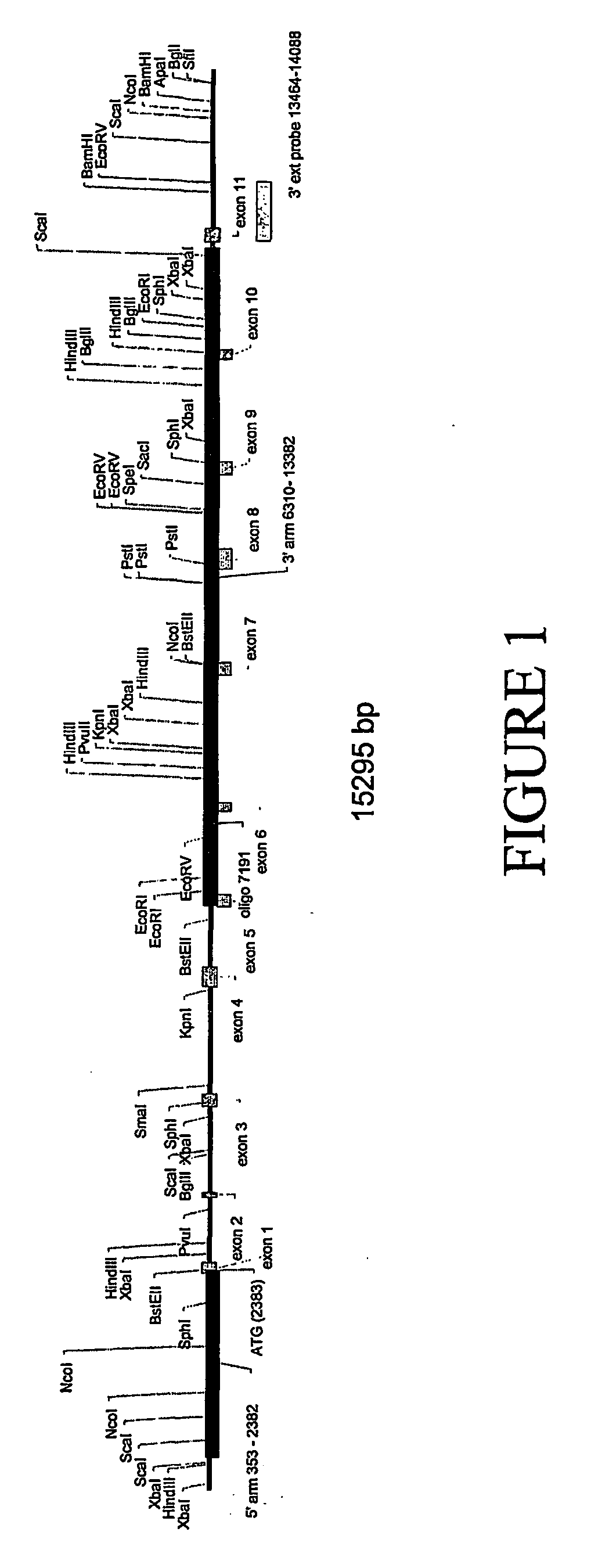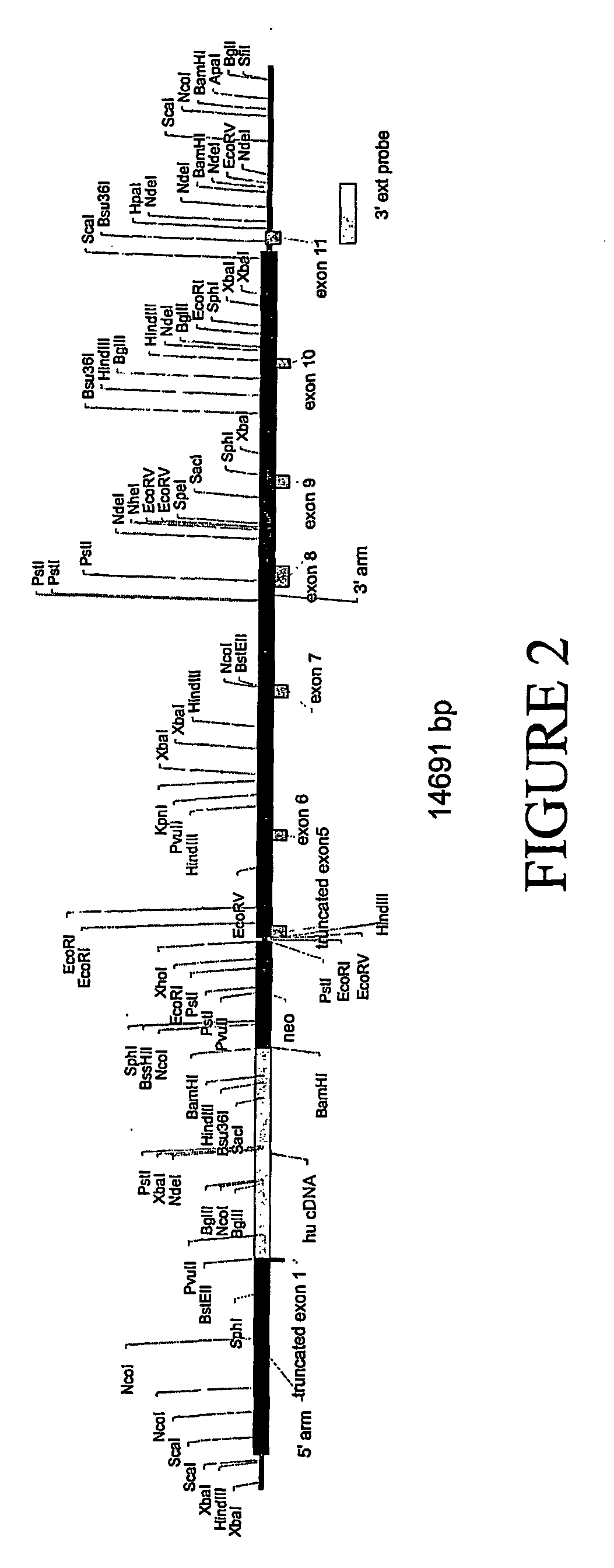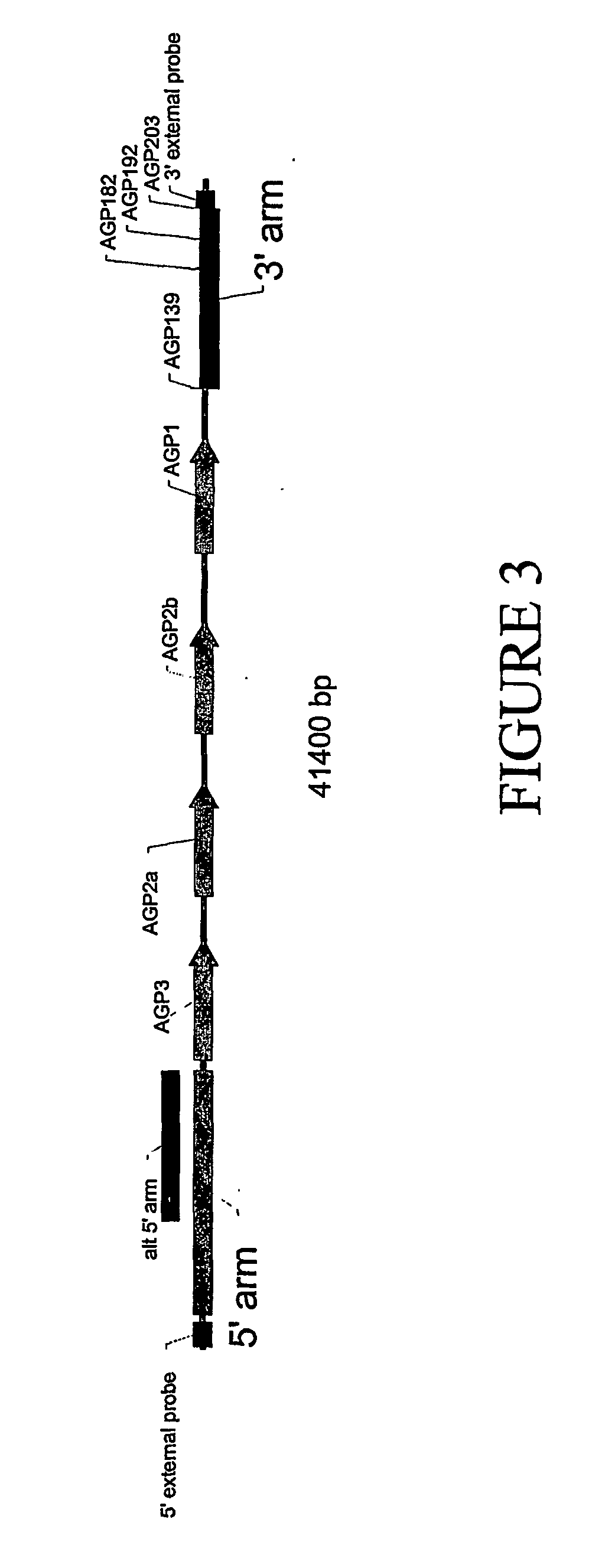Transgenic non-human animals for pharmacological and toxicological studies
a technology of pharmacological and toxicological studies, applied in the field of non-human animals, can solve the problems of reducing the expression level of endogenous polypeptides, and achieve the effect of improving predictability
- Summary
- Abstract
- Description
- Claims
- Application Information
AI Technical Summary
Benefits of technology
Problems solved by technology
Method used
Image
Examples
example 1
Obtaining a Knock-In Mouse in which Human Serum Albumin Replaces the Endogenous Mouse Serum Albumin
Step 1. Obtaining Human Coding Sequences
[0163] The human albumin cDNA sequence (XM—031320) is obtained by PCR of a human foetal liver cDNA library, using primers designed from and based on the sequence set forth in GenBank Accession No. XM—031320 [SEQ ID NO: 3]. For example, the two separate PCR reactions described below generate 5′ and 3′ portions of the gene that overlap across a Bsu36I site. After digestion with Bsu36I, the two halves are joined by ligation into an appropriate vector such as pBluescript (Stratagene), with a neo gene blunt-end ligated into the SmaI site with the BamHI site in the polylinker at the 3′ end of the gene. The following primers can be used for performing the PCR reactions:
[0164] 5′ portion of human ALB CDNA: Forward primer (from start codon, overlapping BstEII site=nt 39-63 of SEQ ID NO: 3); HALB1F=(5′) ATGAAGTGGGTAACCTTTATTTCC (3′) [SEQ ID NO: 26]. R...
example 2a
Obtaining a Mouse in which Human AGP Replaces the Endogenous Mouse AGP
Knock-Out Mouse Genes by Homologous Recombination, then Randomly Integrate Human Genes:
Step 1. Design of a Targeting Construct to Knockout the Entire Mouse AGP Locus
[0187] A BAC sequence has been identified that spans the AGP gene locus in mouse. The BAC is mouse chromosome 4 BAC279 (GenBank Accession No. AF336379). The region has been mapped and four genes (or pseudogenes) have been identified. They span a region extending from approximately 98880 to 120991 in this sequence. A 41400 bp region spanning from position 88681 to position 130080 can be taken from this BAC sequence and used for preparation of the targeting construct. A linear map of this region is shown in FIG. 3 and the sequence relating thereto is set forth in SEQ ID NO: 42.
[0188] The mouse 5′ arm and 3′ arm for the targeting vector are obtained from regions 5′ to the 4 gene locus and 3′ to it, respectively. Such sequences are obtained by PCR u...
example 2b
Knock-Out Mouse genes and Insert Human Genes at Same Locus by Homologous Recombination—Procedure 1
[0199] The preferred strategy involves incorporating the human AGP sequences into a mouse AGP targeting vector, between the 5′ arm and the neo gene. In other words, create a knock-in vector that, upon homologous recombination, both disrupts expression of the mouse AGP genes and also inserts the human AGP genes at the same locus. This strategy requires construction of a large vector. There is evidence in the literature that low copy number vectors such as pBR322 are more amenable to the cloning of large fragments of above 20 kb. The low copy number aids stability of the relatively large plasmids. In a non-ligation mediated cloning procedure, it was shown that high copy vectors such Co1E1-derived pBluescript were capable of cloning up to 25 kb whilst pBR322 were capable of up to 80 kb (Lee et al. 2001, Genomics 73: 56-65).
[0200] The 5′ and 3′ arms together with the neo gene and the hum...
PUM
| Property | Measurement | Unit |
|---|---|---|
| Concentration | aaaaa | aaaaa |
| Acidity | aaaaa | aaaaa |
| Level | aaaaa | aaaaa |
Abstract
Description
Claims
Application Information
 Login to View More
Login to View More - R&D
- Intellectual Property
- Life Sciences
- Materials
- Tech Scout
- Unparalleled Data Quality
- Higher Quality Content
- 60% Fewer Hallucinations
Browse by: Latest US Patents, China's latest patents, Technical Efficacy Thesaurus, Application Domain, Technology Topic, Popular Technical Reports.
© 2025 PatSnap. All rights reserved.Legal|Privacy policy|Modern Slavery Act Transparency Statement|Sitemap|About US| Contact US: help@patsnap.com



